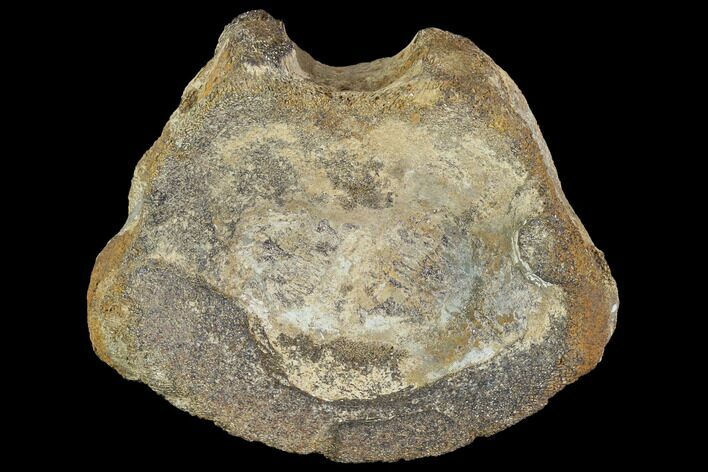This Specimen has been sold.
4.6" Plesiosaur (Colymbosaurus) Vertebra - England
This is nicely preserved, 4.6" wide vertebra of the Jurassic plesiosaur, Colymbosaurus (Kimmerosaurus) cf. trochanterius. It was collected from a gravel pit near Abingdon, England and is weathered around the centrum. The vertebral processes didn't remain intact.
Colymbosaurus is a genus of cryptoclidid plesiosaur from the Late Jurassic (Kimmeridgian-Tithonian) of the UK and Svalbard, Norway.
The first remains attributate to Colymbosaurus were described as a new species of Plesiosaurus, P. trochantericus. The holotype of the species, NHMUK 31787, a humerus (upper arm bone), comes from the Kimmeridgian Kimmeridge Clay Formation of Shotover, Oxfordshire, England. Richard Owen, however, misidentified the bone as a femur, an identification corrected in an 1871 publication on the geology of Oxfordshire.
In the meantime, other plesiosauroid remains were being described from the Kimmeridge Clay by independent workers. The species Plesiosaurus megadeirus was coined for two partial postcranial specimens in a publication cataloging Mesozoic tetrapod specimens in the collections of the Sedgwick Museum of Earth Sciences at the University of Cambridge. The name Pliosaurus portlandicus was coined for a partial hindlimb from Dorset, while John Whitaker Hulke erected the species Plesiosaurus manselii for an incomplete postcranial skeleton (NHMUK 40106) from Kimmeridge, Dorset. Harry Govier Seeley came to recognize Plesiosaurus megadeirus as generically distinct, and coined the name Colymbosaurus for the species. He later referred Pliosaurus portlandicus and Plesiosaurus manselii to Colymbosaurus and considered them distinct from C. megadeirus based on the morphology of the epipodials.
A review of all nominal species of plesiosauroids from the Late Jurassic of England resulted in the recognition of one species of Colymbosaurus, C. trochantericus. P. megadeirus, P. portlandicus, and P. manselii were synonymized with C. trochantericus. Because no skull remains were known, Colymbosaurus was considered possibly a senior synonym of Kimmerosaurus based on comparisons with referred material of Kimmerosaurus.
The distribution of Colymbosaurus was extended beyond the UK when the Norwegian "Tricleidus" svalbardensis was recognized as a valid species of Colymbosaurus, C. svalbardensis. This assignment, along with the discovery of new plesiosauroids from Svalbard, prompted a new revision of Kimmeridge Clay cryptoclidids. Plesiosaurus trochantericus was declared a nomen dubium, being referable to Colymbosaurus but indeterminate at the species level, while Kimmerosaurus and Plesiosaurus manselii were recognized as distinct. Because of this revision, megadeirus was resurrected as the epithet of the type species of Colymbosaurus
Colymbosaurus is a genus of cryptoclidid plesiosaur from the Late Jurassic (Kimmeridgian-Tithonian) of the UK and Svalbard, Norway.
The first remains attributate to Colymbosaurus were described as a new species of Plesiosaurus, P. trochantericus. The holotype of the species, NHMUK 31787, a humerus (upper arm bone), comes from the Kimmeridgian Kimmeridge Clay Formation of Shotover, Oxfordshire, England. Richard Owen, however, misidentified the bone as a femur, an identification corrected in an 1871 publication on the geology of Oxfordshire.
In the meantime, other plesiosauroid remains were being described from the Kimmeridge Clay by independent workers. The species Plesiosaurus megadeirus was coined for two partial postcranial specimens in a publication cataloging Mesozoic tetrapod specimens in the collections of the Sedgwick Museum of Earth Sciences at the University of Cambridge. The name Pliosaurus portlandicus was coined for a partial hindlimb from Dorset, while John Whitaker Hulke erected the species Plesiosaurus manselii for an incomplete postcranial skeleton (NHMUK 40106) from Kimmeridge, Dorset. Harry Govier Seeley came to recognize Plesiosaurus megadeirus as generically distinct, and coined the name Colymbosaurus for the species. He later referred Pliosaurus portlandicus and Plesiosaurus manselii to Colymbosaurus and considered them distinct from C. megadeirus based on the morphology of the epipodials.
A review of all nominal species of plesiosauroids from the Late Jurassic of England resulted in the recognition of one species of Colymbosaurus, C. trochantericus. P. megadeirus, P. portlandicus, and P. manselii were synonymized with C. trochantericus. Because no skull remains were known, Colymbosaurus was considered possibly a senior synonym of Kimmerosaurus based on comparisons with referred material of Kimmerosaurus.
The distribution of Colymbosaurus was extended beyond the UK when the Norwegian "Tricleidus" svalbardensis was recognized as a valid species of Colymbosaurus, C. svalbardensis. This assignment, along with the discovery of new plesiosauroids from Svalbard, prompted a new revision of Kimmeridge Clay cryptoclidids. Plesiosaurus trochantericus was declared a nomen dubium, being referable to Colymbosaurus but indeterminate at the species level, while Kimmerosaurus and Plesiosaurus manselii were recognized as distinct. Because of this revision, megadeirus was resurrected as the epithet of the type species of Colymbosaurus
SPECIES
Colymbosaurus (Kimmerosaurus) cf. trochanterius
LOCATION
Abingdon, Oxfordshire, England
FORMATION
Oxford Clay
SIZE
4.6" wide, 3.8" tall
CATEGORY
SUB CATEGORY
ITEM
#97719
We guarantee the authenticity of all of our specimens.
 Reviews
Reviews













